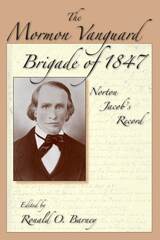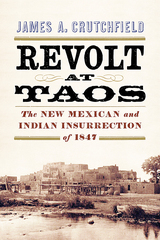2 books about 1847

Mormon Vanguard Brigade Of 1847
Norton Jacob's Record
edited by Ronald O. Barney
Utah State University Press, 2005
There are no historical events that have more iconic significance for the people of Utah than the trek of the vanguard company of Mormons west in 1847. Its meaning may vary, but overall, the march has a highly symbolic and seminal historical importance for virtually all Utahns. While the journey has been widely celebrated, memorialized, and even sanctified and various books have been written about it, there is more that can be said and understood about the migration's place in western history; about its context, including events preceding and following it; and about the real experiences of its participants. Particularly lacking in most published accounts are the stories of the rank and file members, the individuals who, in contrast to the well-known leadership, with Brigham Young at the top, might fittingly be called foot soldiers. The 1847 company had a military-like organization, which is captured by Ronald Barney's term brigade in the title. Norton Jacob was such a man of the ranks in 1847. He had no special status in the Mormon Church, and there was little to make him stand out in the historical record than that he left what is regarded by many trail historians as one of the best and most informative journals of the early Mormon emigration. While the heart of Jacob's record concerns the 1847 journey, there is much more to it. The diary published here begins in 1844, the year of church founder Joseph Smith's murder. It continues through the crisis events that followed: the Mormons' flight from Nauvoo, their trudging journey across Iowa to Winter Quarters, and the beginnings of mass migration to Utah. After the apex of 1847, the arc of the narrative moves through accounts of Jacob's return to Nauvoo late that year and of the much larger Mormon emigration in 1848. It reaches denouement in a short record of his first years in Salt Lake Valley.
[more]

Revolt at Taos
The New Mexican and Indian Insurrection of 1847
James A. Crutchfield
Westholme Publishing, 2015
An Uprising by New Mexicans and Native Americans Against American Rule that Continues to Resonate Today
On the morning of January 19, 1847, Charles Bent, the newly appointed governor of the American-claimed territory of New Mexico, was savagely killed at his home in Don Fernando de Taos, a small, remote town located north of Santa Fe. Those responsible for Bent’s murder were New Mexican settlers and Indians from nearby Taos Pueblo who refused to recognize the United States occupation. With emotions rubbed raw, the natives continued their bloodbath until five more leading citizens were massacred in Taos. During the ensuing months, American civilians and soldiers, along with scores of New Mexicans and Taos Indians, were killed and wounded throughout the region. Less than a month following Bent’s murder, in a two-day battle, volunteer and regular elements of an American army under the command of Colonel Sterling Price emerged victorious after bombarding the insurrectionists at their refuge in the church at Taos Pueblo. Surviving participants in the earlier Taos murders were arrested, tried in American-dominated courts, and, within weeks, hanged for their actions. The murder of Bent and the others at Taos and the subsequent trials and executions brought with them misunderstanding, controversy, mistrust, and recrimination on both sides of the issue. The events also subjected President James K. Polk’s administration to censure over what some critics believed was an overextension of presidential authority in claiming New Mexico as a territory.
In Revolt at Taos: The New Mexican and Indian Insurrection of 1847, writer and historian James A. Crutchfield explores the fast-moving events surrounding the bloody revolt which left native inhabitants of New Mexico wondering how their neighbors and kinsmen could be legally tried, found guilty, and executed for acts they considered to have been honorable ones committed in defense of their country. These concerns have never been adequately addressed and their struggle has been all but scrubbed from the history of American expansion.
On the morning of January 19, 1847, Charles Bent, the newly appointed governor of the American-claimed territory of New Mexico, was savagely killed at his home in Don Fernando de Taos, a small, remote town located north of Santa Fe. Those responsible for Bent’s murder were New Mexican settlers and Indians from nearby Taos Pueblo who refused to recognize the United States occupation. With emotions rubbed raw, the natives continued their bloodbath until five more leading citizens were massacred in Taos. During the ensuing months, American civilians and soldiers, along with scores of New Mexicans and Taos Indians, were killed and wounded throughout the region. Less than a month following Bent’s murder, in a two-day battle, volunteer and regular elements of an American army under the command of Colonel Sterling Price emerged victorious after bombarding the insurrectionists at their refuge in the church at Taos Pueblo. Surviving participants in the earlier Taos murders were arrested, tried in American-dominated courts, and, within weeks, hanged for their actions. The murder of Bent and the others at Taos and the subsequent trials and executions brought with them misunderstanding, controversy, mistrust, and recrimination on both sides of the issue. The events also subjected President James K. Polk’s administration to censure over what some critics believed was an overextension of presidential authority in claiming New Mexico as a territory.
In Revolt at Taos: The New Mexican and Indian Insurrection of 1847, writer and historian James A. Crutchfield explores the fast-moving events surrounding the bloody revolt which left native inhabitants of New Mexico wondering how their neighbors and kinsmen could be legally tried, found guilty, and executed for acts they considered to have been honorable ones committed in defense of their country. These concerns have never been adequately addressed and their struggle has been all but scrubbed from the history of American expansion.
[more]
READERS
Browse our collection.
PUBLISHERS
See BiblioVault's publisher services.
STUDENT SERVICES
Files for college accessibility offices.
UChicago Accessibility Resources
home | accessibility | search | about | contact us
BiblioVault ® 2001 - 2024
The University of Chicago Press









